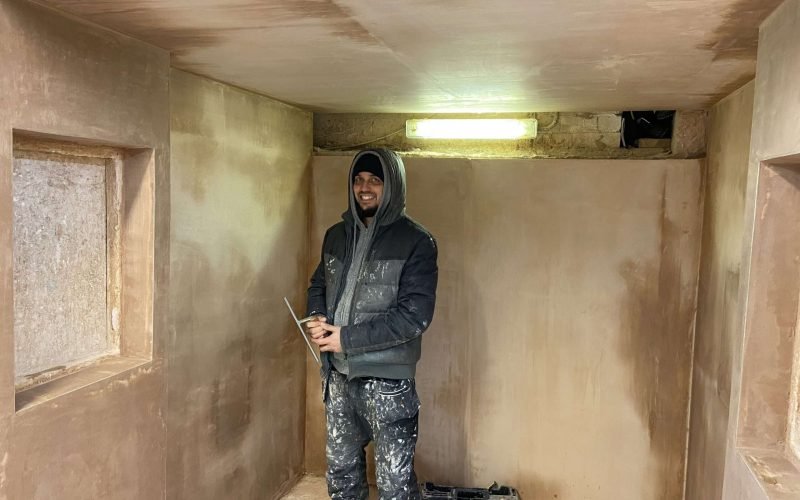Expert Tips for Perfect Plastering: Accomplish a Perfect Finish Each Time
Expert Tips for Perfect Plastering: Accomplish a Perfect Finish Each Time
Blog Article
A Comprehensive Guide to Mastering Plastering Abilities for Your Remodelling Requirements

Essential Devices and Products
In the realm of plastering, having the right tools and products is paramount to achieving a flawless coating. Numerous important devices serve distinct functions, ensuring efficiency and accuracy throughout the smudging process. A premium trowel, for instance, is vital for using and smoothing plaster, while a hawk gives a secure platform for holding the product. A joint blade is likewise critical for detailed job, particularly in edges and edges.
In addition to devices, choosing the appropriate plastering materials is essential. Gypsum-based plasters are typically liked for their versatility and convenience of use, while cement-based alternatives are optimal for outside applications because of their longevity. Water and bonding agents play considerable roles in accomplishing proper consistency and bond, making sure that the plaster adheres properly to the surface area.
Furthermore, protective gear such as masks, handwear covers, and goggles is important to secure versus dust and irritation throughout the application process. By setting up the appropriate combination of tools and products, plasterers can enhance their ability and create high-quality surfaces, ultimately boosting the total workmanship of their work.
Preparing Surface Areas for Plastering
Achieving a smooth and long lasting plaster finish begins with careful prep work of the surface areas to be smudged. This foundational action is important to guaranteeing bond and the longevity of the plaster. Start by analyzing the problem of the substrate-- whether it is drywall, concrete, or masonry-- getting rid of any loosened paint, dirt, or debris that may hinder bonding.
Following, fix any kind of flaws such as splits or holes. Utilize an appropriate filler to attain a degree surface area; this can be important for protecting against future issues. When repaired, make sure the surface is clean and completely dry, as wetness can endanger plaster adherence.
For permeable surface areas, it is recommended to use a bonding representative. This item enhances bond and develops a reputable user interface in between the plaster and substrate. If functioning with previously plastered surfaces, it may be necessary to scuff or sand the location lightly to supply a secret for the brand-new plaster layer.
Smudging Methods and Tips
Understanding plastering methods requires both skill and method to attain a remarkable finish. One necessary technique is the application of the plaster in several slim layers, rather than a solitary thick coat.
When using the surface layer, employ a shoveling technique that entails holding the trowel at a minor angle and operating in a circular activity. This assists to produce a smooth surface and lowers the look of trowel marks. In addition, keep a spray bottle of water handy to mist the surface lightly; this maintains the plaster practical and enables smoother ending up.
Timing is vital; work successfully, as the plaster begins to set. As soon as the plaster has actually tightened yet is still wet, utilize a wet sponge to gently smooth the surface further. Last but not least, allow appropriate drying out time prior to sanding or painting, ensuring your effort leads to a professional, high-grade coating.
Typical Mistakes to Prevent

One more common error is using plaster also heavily. Overzealous applications can cause cracking and long term drying times. It's important to apply plaster in thin, even layers, enabling each layer to dry adequately prior to including more.
Furthermore, not utilizing the right tools can hinder the top quality of the coating. Utilizing improper trowels or mixers can develop disparities in the gluing procedure. Always choose for high-quality Bonuses devices developed for plastering jobs.
Finally, several individuals take too lightly the relevance of timing. Operating in improper temperature levels or moisture degrees can negatively influence plaster curing and drying. It is a good idea to inspect weather conditions and adjust your routine as necessary.
Ending Up Touches for a Specialist Look
The lasts of a smudging project are important for accomplishing a polished, specialist appearance. When the plaster has actually dried completely, the following step is to evaluate the surface for blemishes. Minor bumps, openings, or unequal locations ought to be dealt with utilizing great sandpaper or a fining sand block. This precise attention to information is important for making certain a smooth surface.
After sanding, it's suggested to clean up the surface to get rid of any kind of dust and debris. A moist cloth is effective for this function, adhered to by a complete drying period. If required, using a slim layer of finishing plaster can boost the surface even more, giving a smooth finish.
When the finishing plaster is completely dry, another round of fining sand may be needed to achieve the preferred level of smoothness. Finally, consider using a guide before paint or wallpapering, which will improve attachment and durability.
Conclusion
Grasping plastering skills substantially enhances the high quality of renovation projects. A thorough understanding of necessary tools, surface area preparation, and effective techniques is vital for accomplishing professional outcomes. Understanding of usual blunders permits the evasion of costly mistakes, while attention to ending up touches ensures a polished appearance. Eventually, the combination of these components adds to the production of smooth, sturdy surfaces that boost the aesthetic worth of any kind of area, Look At This underscoring the relevance of experienced plastering in home renovation endeavors.
Water and bonding agents play significant functions in accomplishing proper consistency and adhesion, making sure that the plaster adheres properly to the surface area. Plastering.


Additionally, keep a spray container of water convenient to mist the surface area gently; this keeps the plaster practical and Continue allows for smoother finishing. (Plastering)
If required, using a thin layer of completing plaster can improve the surface even more, providing a smooth surface.
Report this page